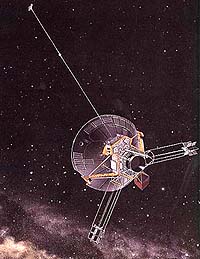
Pioneer 10 is now over 11.74 billion kilometers (7.29 billion miles) from Earth
 Pioneer 10 is now over 11.74 billion kilometers (7.29 billion miles) from Earth |
As of April 30, 2001 Pioneer 10 was 77.693 AU from the Sun and travelling at a relative speed to the Sun of 12.292 km/sec (27,500 mph). The probes distance from Earth was 78.505 AUs, with a round-trip Light Time of 21 hours 45.
When Pioneer 10 reaches a distance of about 1.5 parsec (309,000 AUs) - about 126,000 years from now - it will cease to be dominated by the gravitational field of the Sun.
After that Pioneer 10 will be on an orbital path in the Milky Way galaxy influenced by the field of the stars that it passes. The probe is moving in a straight line away from the Sun at a constant velocity of about 12 km/sec.
Meanwhile, Project Phoenix has been trying to observe Pioneer 10 at Arecibo in Puerto Rico through the auspices of the SETI Institute. However, their most recent observation dates - from Feb 26 to March 5 and from March 8 through 18 for about an hour each night - did not pick up the Pioneer 10 signal.
Power for the Pioneer 10 is generated by the Radioisotope Thermoelectric Generators (RTG's). Heat from the decay of the plutonium 238 isotope is converted by thermoelectric couples into electrical current. The electrical output depends on the hot junction temperature, the thermal path to the radiator fins, and the cold junction temperature.
It is the degradation of the thermoelectric junction that has the major effect in decreasing the power output of the RTG. In the 27-year time scale operation of Pioneer 10, the 92 year half-life of the isotope does not appreciably affect the RTG operation.
The nuclear decay heat will keep the hot junction temperature hot for many years but unfortunately will not be able to be converted into enough electricity to power the transmitter for much longer. How much longer contact with Pioneer 10 can be maintained remains unknown.
Related Links
 Pasadena - Jan. 20 2001
Pasadena - Jan. 20 2001SPACE.WIRE |